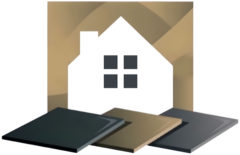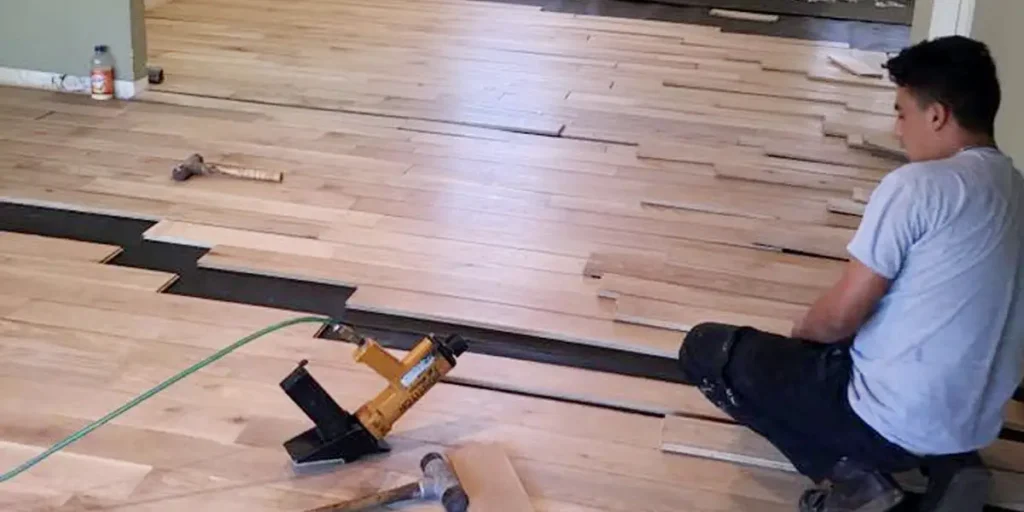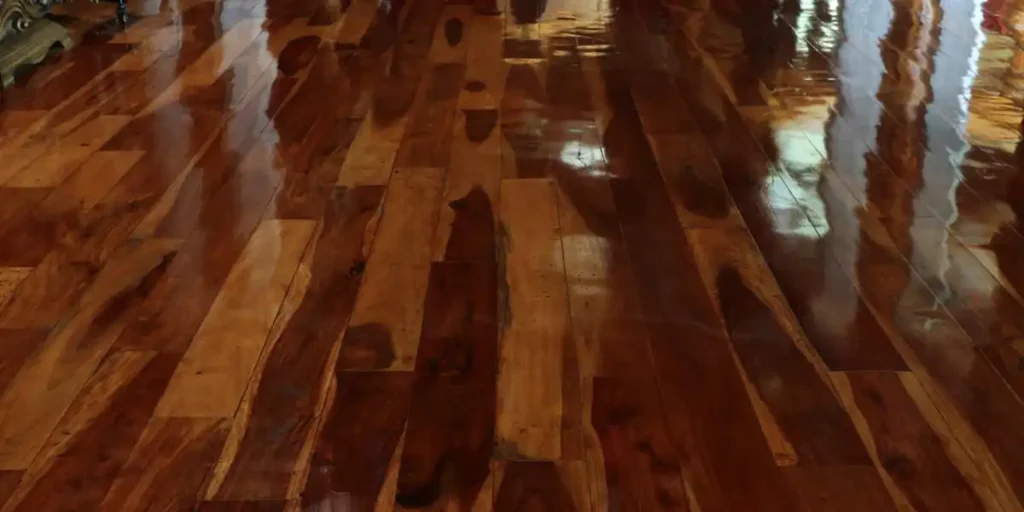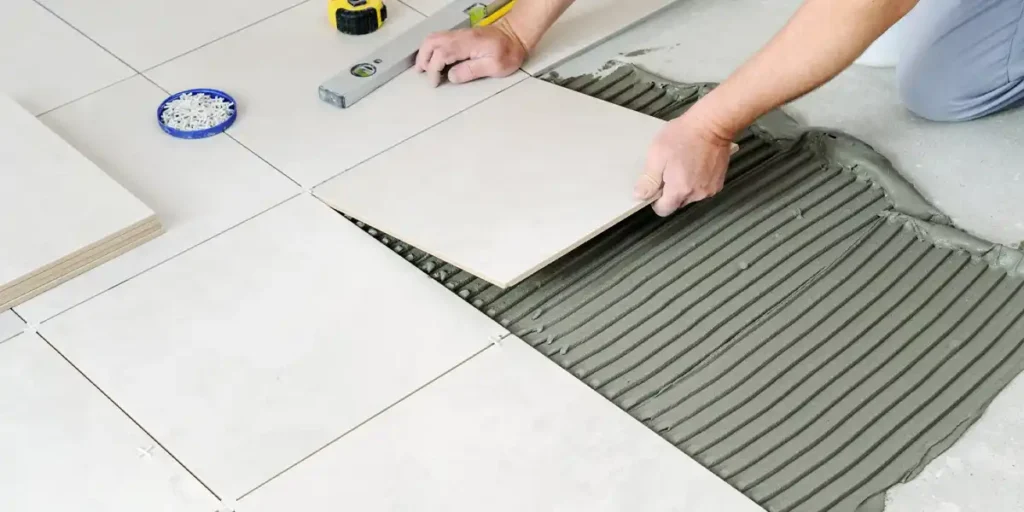Are your hardwood floors betraying your every step with an irritating squeak? Squeaky floors aren’t just annoying—they can be a sign of underlying issues.
Understanding how to stop hardwood floors from squeaking is crucial for maintaining a peaceful home and ensuring your floors’ longevity.
This guide covers everything from DIY solutions to professional repairs and preventative measures.
What Causes Hardwood Floors to Squeak?
Before tackling the problem, it’s essential to understand why hardwood floors squeak. Squeaks typically occur due to friction between floor components or gaps forming over time. Common causes include:
Loose Floorboards
Over time, floorboards can loosen due to wear and tear or poor installation, creating friction when walked on.
Subfloor Issues
A poorly secured subfloor or gaps between the subfloor and joists can lead to squeaks. Temperature and humidity fluctuations exacerbate the problem.
Humidity and Seasonal Changes
Wood naturally expands and contracts with humidity. Seasonal changes can cause gaps or misalignments, leading to squeaky spots.
Structural Movement
Settling of the house or shifting foundations can also create gaps between the flooring materials, causing noise.
By identifying the root cause, you can choose the most effective solution to stop the squeaks.
DIY Solutions: Quick Fixes for Squeaky Floors
If you’re wondering how to stop hardwood floors from squeaking, there are several DIY methods you can try. These are cost-effective and often resolve the issue without requiring professional help.
Method 1: Powdered Lubricant
- Sprinkle talcum powder, graphite powder, or powdered soapstone into the squeaky joints.
- Use a soft brush to push the powder into the cracks.
- Walk over the area to distribute the lubricant evenly.
Why It Works: The powder reduces friction between floorboards, eliminating the squeak.
Method 2: Wood Shims
- Locate the squeaky area from beneath the floor if possible.
- Insert a wood shim between the subfloor and joist to tighten the gap.
- Avoid overforcing the shim, as it could cause further separation.
Why It Works: Shims stabilize loose sections and prevent movement.
Method 3: Screws and Nails
- Secure loose floorboards by driving finishing nails or wood screws through the boards into the subfloor.
- For a cleaner finish, countersink the nails and fill the holes with wood filler.
Why It Works: This method directly addresses loose boards by anchoring them firmly.
Method 4: Adhesive Solutions
- Apply wood glue or construction adhesive to gaps between floorboards.
- Use clamps or weights to press the boards together until the adhesive sets.
Why It Works: Glue fills and secures gaps, reducing movement and squeaking.
Professional Fixes: When to Call in the Experts
Sometimes, the problem is too extensive for DIY methods. Here’s how professionals handle how to stop hardwood floors from squeaking:
Subfloor Reinforcement
Professionals may remove sections of flooring to secure the subfloor to the joists with screws or adhesive. This ensures a stable foundation.
Injection Repair
For squeaks caused by gaps, pros often use a wood adhesive injection to fill voids between the subfloor and joists without removing floorboards.
Complete Floor Replacement
In severe cases, where structural issues are widespread, replacing the affected area of flooring might be necessary. While costly, this ensures a squeak-free and durable floor.
Preventative Measures: Keeping Your Floors Quiet
The best way to handle squeaky floors is to prevent them from happening in the first place. Here’s how:
Humidity Control
Maintain consistent humidity levels in your home using a humidifier or dehumidifier. Ideal humidity levels for hardwood floors are between 35-55%.
Proper Installation
Hire professional installers to ensure your flooring and subfloor are properly secured from the start. Quality installation reduces the risk of future squeaks.
Routine Maintenance
Regularly inspect and maintain your floors to address minor issues before they escalate. Tighten loose boards and check for subfloor gaps annually.
Use Rugs and Mats
Place rugs or mats in high-traffic areas to reduce wear and tear on your hardwood floors.
Tools You’ll Need for DIY Repairs
Here’s a quick checklist of tools and materials you’ll need for tackling squeaky hardwood floors:
- Talcum powder or graphite powder
- Hammer and finishing nails
- Drill and wood screws
- Wood glue or construction adhesive
- Shims
- Wood filler
- Sandpaper
- Rug pads or area rugs
Having the right tools ensures a smoother repair process and better results.
Final Thoughts
Squeaky hardwood floors are more than just an annoyance—they’re a call to action. By addressing the issue promptly with the solutions outlined in this guide, you can restore peace and ensure the longevity of your flooring. Whether through simple DIY methods or professional intervention, knowing how to stop hardwood floors from squeaking will save you time, money, and frustration.
Ready to silence your squeaky floors? Contact Cardenas Flooring for expert hardwood floor repair and maintenance services. Our skilled professionals will keep your floors beautiful and quiet for years to come!
FAQs
Q: How much does it cost to fix squeaky hardwood floors?
A: The cost depends on the severity of the issue. DIY fixes like talcum powder or wood shims can cost under $20, while professional repairs, such as subfloor reinforcement or injection solutions, typically range from $100 to $500 per area. For extensive repairs, the costs may increase significantly.
Q: Can squeaky floors damage my home?
A: While squeaky floors are not immediately harmful, they can indicate underlying structural issues like loose subfloors or gaps between joists. If left unresolved, these issues may worsen over time, potentially leading to more significant damage that can compromise the floor’s durability and stability.
Q: Are squeaky floors a sign of poor installation?
A: Not necessarily. Squeaky floors can result from natural wear, humidity fluctuations, or the settling of the house. However, improper installation, such as insufficient fastening or poor subfloor preparation, can increase the likelihood of squeaks over time.
Q: Can carpeted floors squeak too?
A: Yes, squeaks can occur beneath carpeted floors due to loose subfloors, gaps in the joists, or structural movement. The repair process often involves accessing the subfloor from below or removing a section of carpet to tighten loose components.
Q: Do I need to remove my hardwood floor to fix squeaks?
A: In most cases, no. Many squeaky floor issues can be resolved without removing the floorboards. Techniques such as applying powdered lubricant, driving screws, or injecting adhesives address the problem from the surface or underneath, making floor removal unnecessary.




